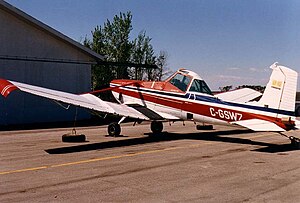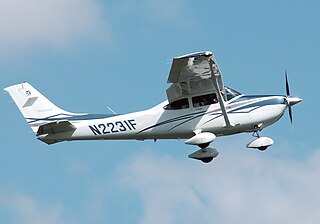
The Cessna 182 Skylane is an American four-seat, single-engined light airplane built by Cessna of Wichita, Kansas. It has the option of adding two child seats in the baggage area.

The Cessna 120,140, and 140A, are single-engine, two-seat, conventional landing gear (tailwheel), light general aviation aircraft that were first produced in 1946, immediately following the end of World War II. Production ended in 1951, and was succeeded in 1959 by the Cessna 150, a similar two-seat trainer which introduced tricycle gear. Combined production of the 120, 140, and 140A was 7,664 units in five years.

The Distributor Wing DW-1 was a prototype agricultural aircraft of unorthodox design, designed by Ken Razak in the United States and marketed by Aerial Distributors in the 1960s.

The Cessna 180 Skywagon is a four- or six-seat, fixed conventional gear general aviation airplane which was produced between 1953 and 1981. Though the design is no longer in production, many of these aircraft are still in use as personal aircraft and in utility roles such as bush flying.

The Cessna 205, 206 and 207, known primarily as the Stationair, are a family of single-engined, general aviation aircraft with fixed landing gear, used in commercial air service as well as for personal use. The family was originally developed from the popular retractable-gear Cessna 210 and produced by the Cessna Aircraft Company.

The Beechcraft Musketeer is a family of single-engined, low-wing, light aircraft that was produced by Beechcraft. The line includes the Model 19 Musketeer Sport, the Model 23 Musketeer, Custom and Sundowner, the Model 23-24 Musketeer Super III, the retractable gear Model 24R Sierra and the military CT-134 Musketeer.

The Cessna 400, marketed as the Cessna TTx, is a single-engine, fixed-gear, low-wing general aviation aircraft built from composite materials by Cessna Aircraft. The Cessna 400 was originally built by Columbia Aircraft as the Columbia 400 until December 2007. From 2013, the aircraft was built as the Cessna TTx Model T240.

The Cessna 175 is a light four-seat, single-engine, fixed wing aircraft produced by Cessna between 1958 and 1962. A deluxe model known as the Skylark was introduced in 1959 for the 1960 model year. The aircraft is similar to the popular Cessna 172 but has higher gross weight and a more powerful engine with a geared reduction drive.

The Cessna 185 Skywagon is a six-seat, single-engined, general aviation light aircraft manufactured by Cessna. It first flew as a prototype in July 1960, with the first production model completed in March 1961. The Cessna 185 is a high-winged aircraft with non-retractable conventional landing gear and a tailwheel.

The Cessna 421 Golden Eagle is an American six or seven seat twin-engined light transport aircraft, developed in the 1960s by Cessna as a pressurized version of the earlier Cessna 411.

The Cessna 340 is a twin piston engine pressurized business aircraft that was manufactured by Cessna.

The Air Tractor AT-300 is a family of agricultural aircraft that first flew in the United States in September 1973. Type certification was awarded to Air Tractor in November the same year, and serial production commenced in 1976. Of low-wing monoplane taildragger configuration, they carry a chemical hopper between the engine firewall and the cockpit.

The PZL-106 Kruk is a Polish agricultural aircraft designed and built by WSK PZL Warszawa-Okęcie.
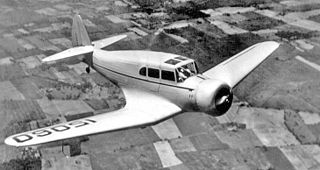
The Fairchild Model 45 was a 1930s American five-seat cabin monoplane aircraft designed and built by Fairchild.
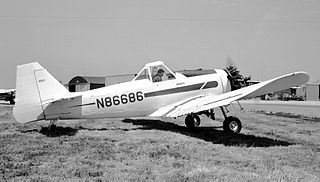
The Weatherly Model 201 is a 1960s American agricultural monoplane designed and built by the Weatherly Aviation Company of Hollister, California.

The Macchi MB.308, later Aermacchi MB-308, is a light aircraft produced in Italy in the late 1940s.
The Harris Geodetic LW 108 is an American homebuilt aircraft that was designed by J. Warren Harris of Vernal, Utah and made available in the form of plans for amateur construction.
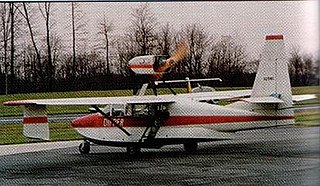
The Collins Dipper was an American homebuilt flying boat that was designed and produced by Collins Aero of Chadds Ford, Pennsylvania and first flown in 1982. The aircraft was supplied in the form of plans for amateur construction. Only one was built and none remain registered.
The Javelin V6 STOL is an American STOL homebuilt aircraft that was designed and produced by Javelin Aircraft of Wichita, Kansas. When it was available the aircraft was supplied in the form of plans for amateur construction.
The VSR SR-1 Snoshoo is an American homebuilt Formula One racing aircraft that was designed by Alan VanMeter and A.J. Smith and produced by VanMeter Smith Racing (VSR) of Wichita, Kansas. It was designed in 1993 and first flown in 1997. The aircraft is supplied in the form of plans for amateur construction, with some key parts available to speed construction.
